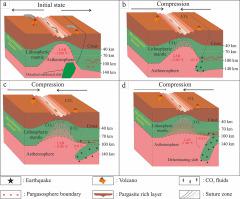Global and Planetary Change ( IF 4.0 ) Pub Date : 2021-06-18 , DOI: 10.1016/j.gloplacha.2021.103547 István J. Kovács , Nóra Liptai , Alexander Koptev , Sierd A.P.L. Cloetingh , Thomas P. Lange , Liviu Mațenco , Alexandru Szakács , Mircea Radulian , Márta Berkesi , Levente Patkó , Gábor Molnár , Attila Novák , Viktor Wesztergom , Csaba Szabó , Tamás Fancsik

|
Apart from the lithosphere-asthenosphere boundary (LAB), mid-lithospheric discontinuities (MLDs) in thick and old continental lithospheres appear to play an important role in global plate tectonics. Initiation of intra-continental subduction, delamination of the lower continental lithospheric mantle and removal of cratonic roots are likely to occur along MLDs.
Here we introduce the ‘pargasosphere’ hypothesis which could account for the origin of both boundaries. The observation that pargasitic amphibole is stable even at very low bulk ‘water’ concentration (~a few hundreds ppm wt.) implies that the solidus of the shallow upper mantle (<3 GPa) is usually the pargasite dehydration solidus at ~1100 °C. In young continental and oceanic lithosphere (<70 Ma) this solidus defines the LAB. The LAB separates the deeper, partial melt bearing asthenosphere from the shallower melt barren lithosphere, explaining their contrasting rheology.
In old continents pargasite breaks down at the sub-solidus pargasite dehydration boundary at ~3 GPa and liberates ‘water’-rich fluids. This latter process may be responsible for the formation of MLDs. The occurrence of partial melts or fluids beyond the pargasite stability field can explain commonly observed geophysical anomalies associated with the LAB and MLDs.
We present forward modelled variations of shear wave velocity and resistivity at the LAB and MLDs for idealised lithospheric columns. These columns are constructed based on the ‘pargasosphere’ hypothesis and geotherms corresponding to continental lithospheres with various tectono-thermal ages. The ‘pargasosphere’ hypothesis offers a number of other empirically testable implications. For instance, cooling asthenosphere beneath young extensional continental and oceanic lithosphere settings can be the source of surface CO2 emanations even at locations distant from areas with active volcanoes. The Vrancea zone (Eastern Europe) appears to be a suitable site for testing the ‘pargasosphere’ hypothesis for elucidating the origin of intermediate-depth earthquakes (70–300 km) and to explain the delamination of the lower continental lithospheric mantle.
中文翻译:

“大气圈”假说:从新视角看全球板块构造
除了岩石圈-软流圈边界(LAB),厚的和古老的大陆岩石圈中的中间岩石圈不连续性(MLDs)似乎在全球板块构造中发挥着重要作用。大陆内俯冲的开始、大陆下部岩石圈地幔的分层和克拉通根的移除很可能沿着 MLD 发生。
在这里,我们引入了“大气圈”假设,它可以解释两个边界的起源。即使在非常低的体积“水”浓度(~几百 ppm wt.)下,帕加西角闪石的观察结果也表明,浅层上地幔 (<3 GPa) 的固相线通常是约 1100 °C 的帕加西角闪石脱水固相线. 在年轻的大陆和海洋岩石圈 (<70 Ma) 中,该固相线定义了 LAB。LAB 将较深的、部分含熔体的软流圈与较浅的熔体贫瘠岩石圈分开,解释了它们对比的流变学。
在古老的大陆中,帕加石在~3 GPa 的亚固相线脱水边界处分解,并释放出富含“水”的流体。后一过程可能是形成 MLD 的原因。部分熔体或流体的出现超出了帕加石稳定场,可以解释常见的与 LAB 和 MLD 相关的地球物理异常。
我们提出了理想化岩石圈柱的 LAB 和 MLD 处剪切波速度和电阻率的正向建模变化。这些柱子是根据“大气圈”假说和与具有各种构造热年龄的大陆岩石圈相对应的地热学构建的。'pargasosphere' 假设提供了许多其他经验可检验的含义。例如,在年轻的伸展大陆和海洋岩石圈环境下冷却软流圈可能是地表 CO 2的来源即使在远离活火山地区的地方也会散发出辐射。Vrancea 区(东欧)似乎是检验“大气圈”假说的合适地点,以阐明中深度地震(70-300 公里)的起源并解释下大陆岩石圈地幔的分层。







































 京公网安备 11010802027423号
京公网安备 11010802027423号